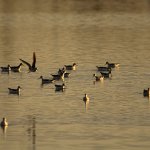By: Isadora Angarita-Martínez & Arne Lesterhuis
Conservation Specialists, WHSRN Executive Office
Flyways are the channels by which the birds fly the length and breadth of the globe. In the Americas there are three main flyways connecting North, Central and South America and the Caribbean. The Atlantic and Pacific flyways have been the subject of several initiatives and strategic planning processes have been completed for both. These initiatives were designed to assure the conservation of shorebirds that prefer or require coastal environments. But the needs of the shorebirds that migrate through the interior of the Americas have not yet been addressed by a strategic plan. These shorebirds use habitats such as lowland and highland grasslands, saline lakes and lagoons, inland wetlands and other, non-natural environments for example, ricefields.
At the end of 2019 the Midcontinent Shorebird Conservation Initiative (MSCI) was launched to support the conservation of shorebirds along the Midcontinent Flyway while also contributing to human welfare along the same flyway. The Initiative involves a series of steps and processes in which different stakeholders, including scientists, conservationists, public and private sector workers, local communities and local authorities are working together to address the most urgent conservation threats that shorebirds face throughout their life cycles.
To facilitate the planning process, the flyway was subdivided into North America and South America. In North America the flyway covers interior regions of the Arctic and Boreal Zone (USA and Canada), the Great Plains (Canada, Mexico, USA), the Mississippi Valley (Canada, USA) and the west coast of the Gulf of Mexico (Mexico and USA).
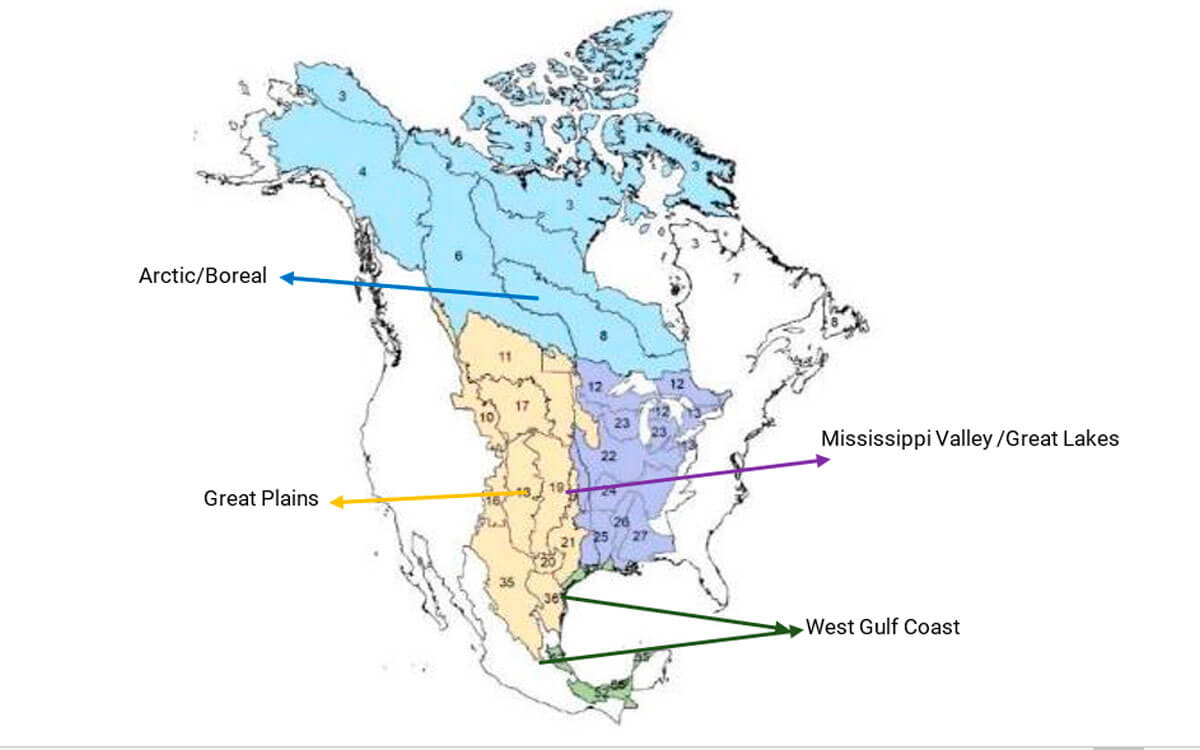
Regions covered by the Midcontinent Flyway in North America
The focus in South America is on biomes and key ecosystems, which include the Llanos of Orinoco (Colombia and Venezuela), Beni Savannas (Bolivia), Chaco/Pantanal (Argentina, Bolivia, Brazil and Paraguay), Pampas (Argentina, Brazil, Uruguay), Patagonian Steppe (Argentina and Chile), the Amazon river system, as well as the Inter-Andean Valleys and High-Andean zones (from Venezuela to Argentina and Chile).
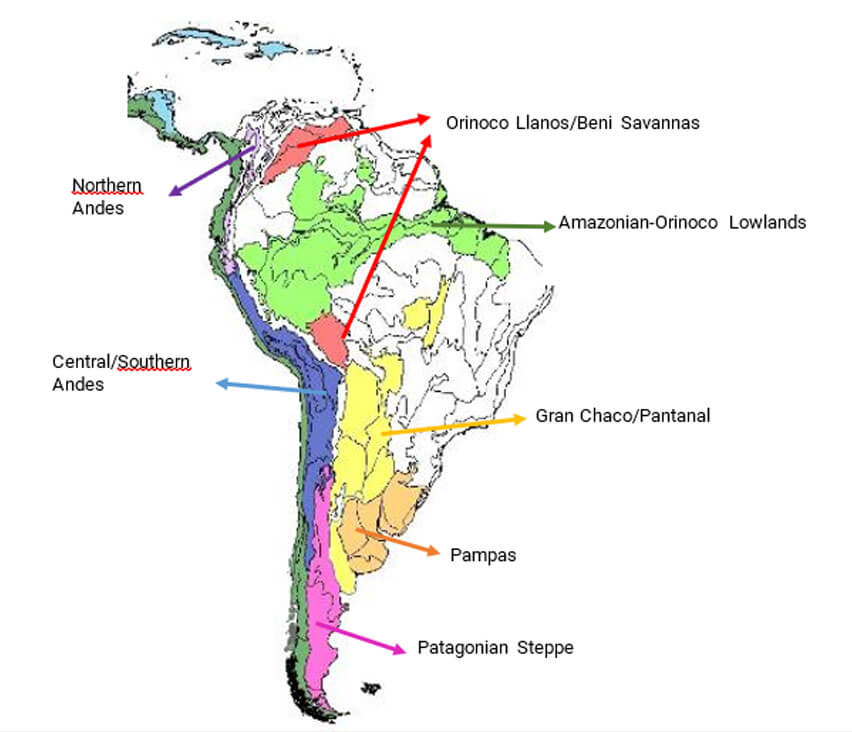
Regions covered by the Midcontinent Flyway in South America
Following similar criteria to those used in the Atlantic and Pacific Initiatives, the MSCI identified certain focal species for conservation. Species selected are of conservation concern, use a variety of habitats and latitudes along the flyway, are representative of the diversity of shorebirds across the hemisphere, are linked to existing conservation planning efforts, and the restauration of their populations is achievable.
The Buff-breasted Sandpiper (Calidris subruficollis) is one of the selected focal species, and one of the most emblematic species of the Midcontinent Flyway. It uses natural grasslands along its migration through the interior of the continent, depending on important WHSRN sites such as Beaverhill Lakes (Canada), Flint Hills and Rainwater Basin (USA), Sabanas de Paz de Ariporo y Trinidad (Colombia), Reserva Natural Barba Azul (Bolivia) and Bahía de Asunción (Paraguay). Its wintering areas are in the pampa region of the Southern Cone of South America at sites such as Estancia Medaland and Bahía Samborombón (Argentina) and Laguna de Rocha (Uruguay). The Buff-breasted Sandpiper occurs regularly at nine of the 30 WHSRN sites along the Midcontinent Flyway and all of these are representative of the biomes and ecosystems that are characteristic of the flyway.
Sites of importance for other species selected as conservation targets along the Midcontinent Flyway include for example Chaplin-Old Wives-Reed Lakes and Quill Lakes (Canada) for the interior population of Piping Plover (Charadrius melodus circumcinctus); Great Salt Lake (USA) for the interior population of Snowy Plover (Charadrius nivosus) and the Marbled Godwit (Limosa fedoa); Llano de la Soledad and Pastizales de Janos y Ascensión in Mexico for the Mountain Plover (Charadrius montanus) and Long-billed Curlew (Numenius americanus); and Laguna Mar Chiquita (Argentina) for the Wilsonʼs Phalarope (Phalaropus tricolor), Lesser Yellowlegs (Tringa flavipes), American Golden-Plover (Pluvialis dominica) and Hudsonian Godwit (Limosa haemastica).
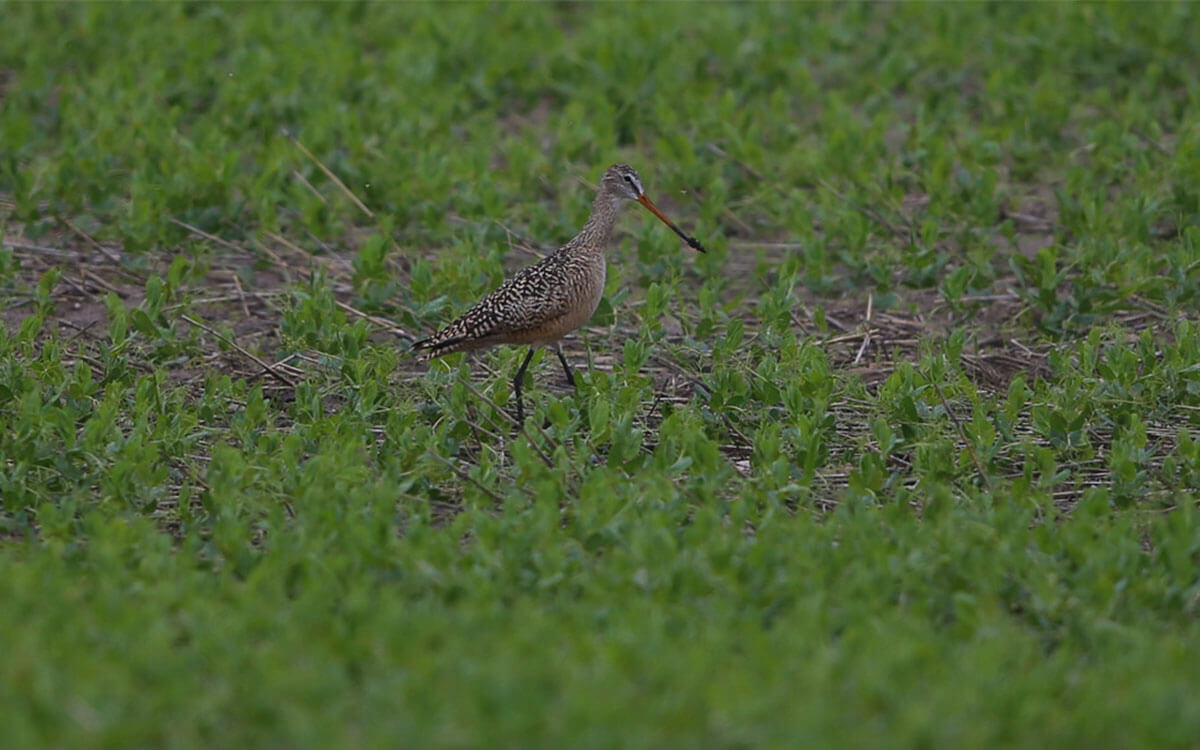
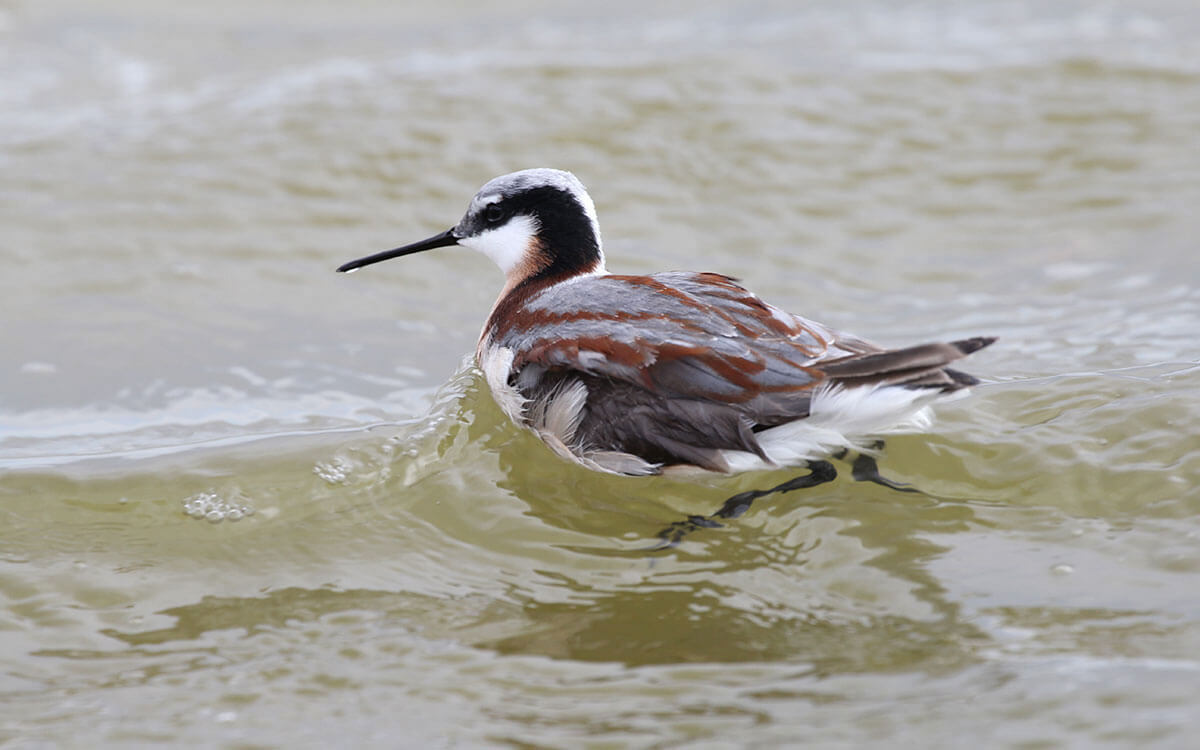
Left: Marbled Godwit (Limosa fedoa) in Saskatchewan, Canadá. Photo: Brad Winn. Right: Wilsonʼs Phalarope (Phalaropus tricolor) at the WHSRN site Cheyenne Bottoms. Photo: Monica Iglecia.
.
Compared to the number of sites of importance along the Atlantic and Pacific flyways, relatively few WHSRN sites have been identified along the Midcontinent Flyway. Of all the WHSRN sites (107 in total), only 30% are within the Midcontinent Flyway, and most of these are in the northern hemisphere. Additionally, the majority of the WHSRN sites are designated for Nearctic species. Of the nine resident shorebird species in South America that were selected as conservation targets in the MSCI, there exist WHSRN sites designated for only three of them: Two-banded Plover (Charadrius falklandicus), Tawny-breasted Dotterel (Oreopholus ruficollis) and Magellanic Plover (Pluvianellus socialis). The Two-banded Plover occurs along all three flyways, however there are no sites designated for the species within the Midcontinent Flyway.
Through the MSCI and its strategic planning process it is hoped that the knowledge gaps on important habitats within the Flyway will be resolved with the identification of other potential WHSRN sites. The WHSRN Executive Office has analyzed data on various species of shorebirds along the flyway, and has identified a number of potentially important sites that comply with WHSRN criteria. Many of these are in South America and host important populations of resident species that form part of the focal list for conservation of the Midcontinent Initiative. This includes sites for poorly-known species such as Rufous-bellied Seedsnipe (Attagis gayi), Gray-breasted Seedsnipe (Thinocorus orbignyianus) and Diademed Sandpiper-Plover (Phegornis mitchellii). Strategic planning allows regional experts to evaluate the relevance of such sites, and to identify key stakeholders within them, thereby creating a list of sites at which to focus conservation efforts along the Midcontinent Flyway.
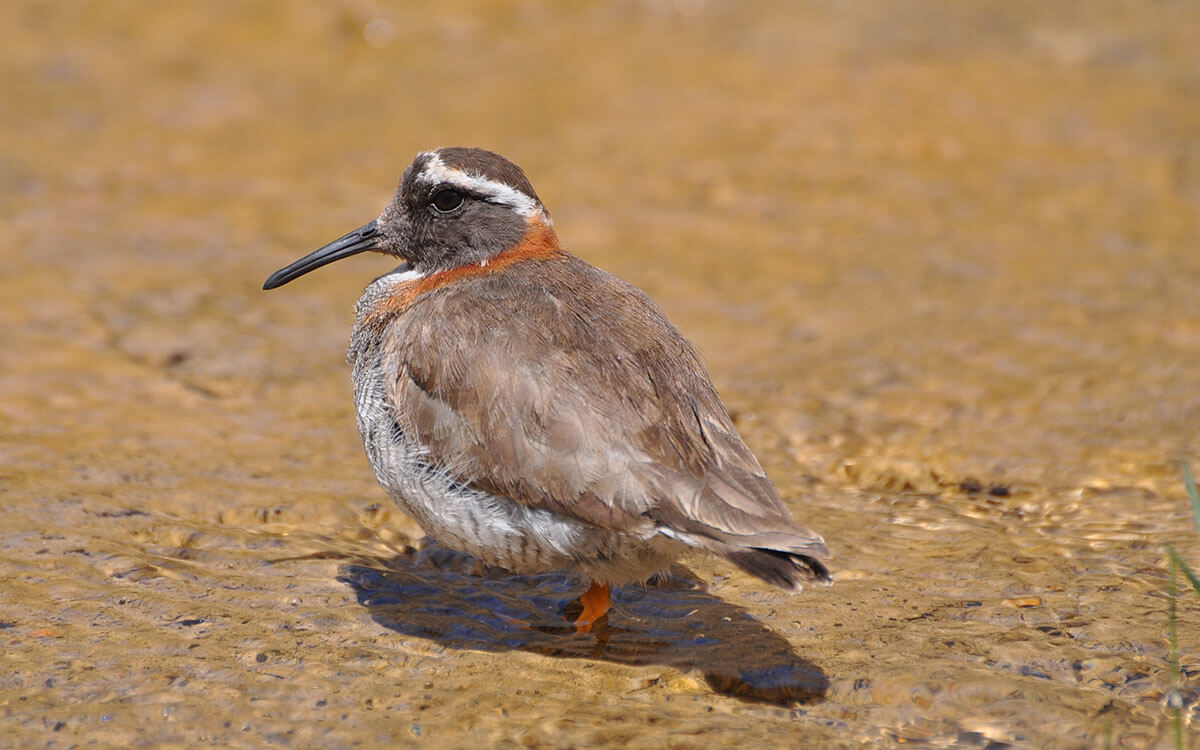
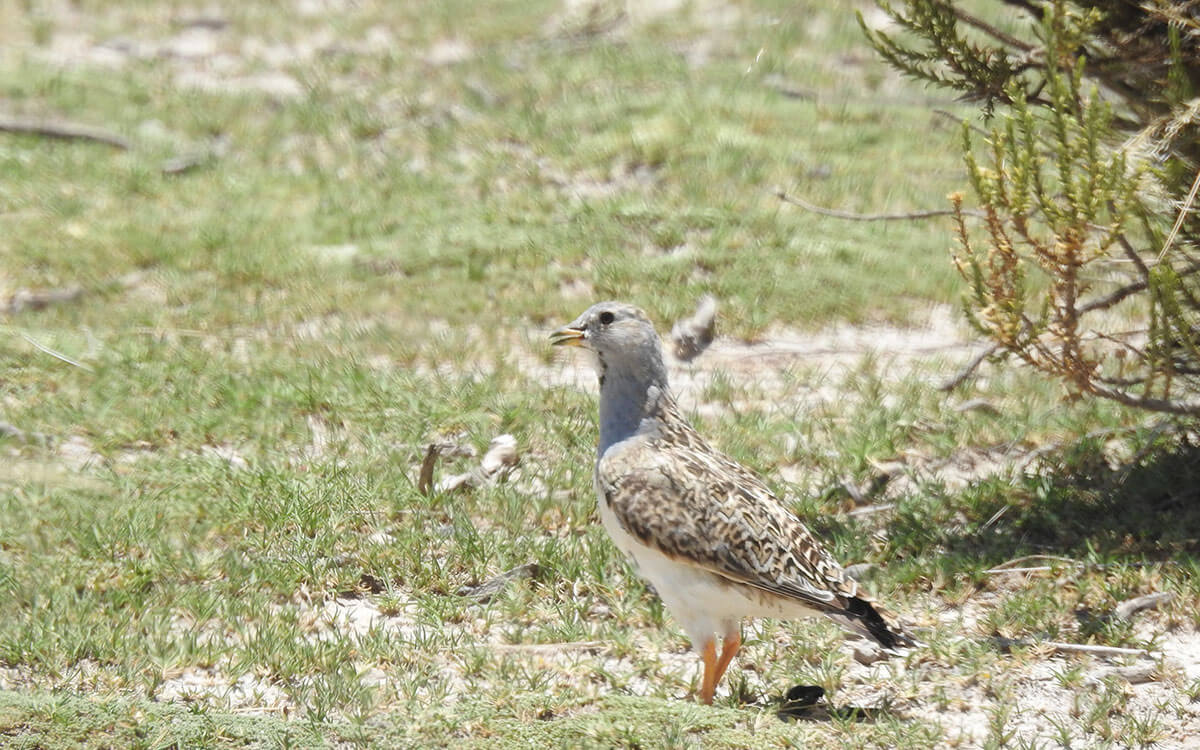
Left: Diademed Sandpiper-Plover (Phegornis mitchellii) is a globally Near Threatened species and needs WHSRN sites on the Midcontinent Flyway to be identified. Photo: Diego Luna-Quevedo. – Right: Gray-breasted Seedsnipe (Thinocorus orbignyianus) is a focal resident species of the Midcontinent Shorebird Conservation Initiative for which no WHSRN sites have yet been designated. Photo: Arne J. Lesterhuis.
The WHSRN Executive Office receives new data on a daily basis and continues to analyze and incorporate it into the analyses of potential sites along the Midcontinent Flyway. If you are interested in contributing data to this analysis, or in reviewing the list of potential sites and verifying if your site qualifies, please contact Arne Lesterhuis. If you are interested in participating in the strategic planning process of the Midcontinent Flyway please contact Isadora Angarita-Martínez.
The development of the MSCI and its strategic plan have been possible thanks to the generous support of the U.S. Fish and Wildlife Service, Environment and Climate Change Canada, ConocoPhillips, U.S. Forest Service – International Programs and a large number of members and collaborators across the Americas. It has been carried out under the coordination of U.S. Fish and Wildlife Service, Manomet Inc. and Conservation of Arctic Flora and Fauna, the Biodiversity Working Group of the Arctic Council.
Cover Photo: Buff-breasted Sandpiper (Calidris subruficollis), an emblematic species of the Midcontinent Flyway, in flight at the WHSRN site Bahía Samborombón. Photo: Brad Winn.






